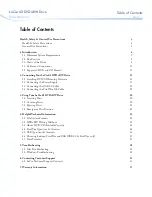
Parameters 215
Automatic
The drive automatically selects the correct output frequency
to start a rotating motor. This is useful for flying starts: if the
motor is already rotating, the drive will start smoothly at the
current frequency.
Note:
Cannot be used in multimotor systems.
2
Torque boost
The drive pre-magnetizes the motor before the start. The pre-
magnetizing time is defined by parameter
.
Torque boost is applied at start. Torque boost is stopped
when output frequency exceeds 20 Hz or when it is equal to
the reference value. See parameter
This mode should selected if a high break-away torque is
required.
Note:
This mode cannot be used to start into a rotating motor.
WARNING!
The drive will start after the set pre-
magnetizing time has passed even if motor
magnetization is not completed. In applications where
a full break-away torque is essential, ensure that the constant
magnetizing time is long enough to allow generation of full
magnetization and torque.
3
Auboost
Automatic start with torque boost.
Automatic start is performed first and the motor is
magnetized. If the speed is found to be zero, torque boost is
applied.
4
Flying start
The drive automatically selects the correct output frequency
to start a rotating motor. If the motor is already
rotating, drive will start smoothly at the current frequency. The
mode will start the motor with vector control and switch to
scalar control on the fly when the motor speed has been
found. Compared to the Automatic start mode, Flying start
detects the motor speed faster. Flying start requires more
accurate information about motor model. Therefore standstill
ID run is done automatically when the drive is started for the
first time after selecting Flying start. Motor plate values should
be accurate. Wrong plate values may decrease the starting
performance.
Note
During flying start, the drive will at first run in vector
control mode. This is why, when using flying start, the drive
nominal current setting must be in the allowed range for
vector control mode, see parameter
5
Flying start+boost
Flying start with torque boost.
Flying start is performed first and the motor is magnetized. If
the speed is found to be zero, torque boost is applied.
6
Defines the DC hold frequency, which is used instead of
parameter
when the motor is in scalar
and section
5.00
0.00…1000.00 Hz
DC hold frequency.
1 = 1
Defines the start delay. After the conditions for start have
been fulfilled, the drive waits until the delay has elapsed and
then starts the motor. During the delay, warning
is shown.
Start delay can be used with all start modes.
0.00
0.00…60.00 s
Start delay
1 = 1
No.
Name/Value
Description
Def/FbEq16
Summary of Contents for ACS560
Page 1: ...ABB GENERAL PURPOSE DRIVES ACS560 standard control program Firmware manual...
Page 4: ...4...
Page 30: ...30 Start up control with I O and ID run...
Page 32: ...32 Using the control panel...
Page 100: ...100 Program features...
Page 153: ...Control macros 153...
Page 160: ...160...
Page 374: ...374 Parameters...
Page 408: ...408 Additional parameter data...
Page 466: ...466 Fieldbus control through the embedded fieldbus interface EFB...
Page 504: ...504 Control chain diagrams...
Page 508: ...508 Parameterization with drive composer...
Page 512: ...512 Parameterization with automation builder drive manager...
















































